Buzz Aldrin’s Race into Space is a space program simulator and strategy game. It was developed for the PC and was released in 1993. While that was a pretty long time ago, I feel that this overlooked gem can still bring some things to the table, and with the recent resurgence of space program games like Kerbal Space Program, Buzz Aldrin’s Space Program Manager and Race to Mars, now seems to be the time to do a review of the old game.
I’ve played it around eight hours, completing a game, but lost the space race to the Americans who pulled a moon landing in 1968, and it was a roller-coaster ride to the very end. Indeed, I had a good shot for the moon, and the cosmonauts Gagarin, Aksynov and Lyakhov were en route to the moon when calamity struck with the engine refusing to disengage. May those brave souls rest in peace.
Buzz Aldrin’s Race into Space, or BARIS for short, is quite like X-COM in that you tend to grow attached to your cosmonauts. Since you start the game in the pre-space flight era, you recruit all your own astronauts, watching them go through training and the different manned programs and watching them return from a bad mission in one piece. You have to be careful, sending up a badly trained cosmonaut on a craft with low safety, and odds are you’ll be watching them be marched into Arlington Cemetery or the Kremlin Wall.
What does Buzz Aldrin’s Race into Space bring to the table
BARIS did some pretty neat things for the time. It’s a surprisingly in-depth game, covering almost all the space programs concepts of the time, including Apollo, Soyuz and some rockets that never even left the drawing board, like the Nova. There are a lot of different missions to do on your way to the moon, such as sending a space probe to Saturn or Jupiter, doing a lunar flyby, establishing an orbital lab and a lot more.
The game is turn-based, with the player receiving funds at the beginning of every year depending on how well they are doing. The better they are doing, the more funding they will receive from the government. Also, at the beginning of every turn there’s a new video, which is like the game randomly selecting an event card from the event deck. These events can completely change the way your space program is developing, with things like an astronaut getting killed in a car crash to a failure mode found on a rocket type.
The player also has to research new technologies and new programs, things like bigger capsules, EVA suits and more. For the purpose of this review, I’m going to start again, and go through the game start screen.
When you click New Game, you are presented with a number of options for the game. There are three difficulty settings for the AI, but the AI is incredibly clever on all three, instead, the difficulty settings are handicaps, and even with the player on easy and the AI on hard mode, it’s very possible for the AI to claw its way to victory on top of a mound of melted capsules. You can also set the other faction to be human controlled, which makes the game Hot seat.
There are two game modes, Historical and Basic. Basic makes both teams equally balanced, while historical makes the space programs as they really were, with American hardware being more expensive but more reliable, and Soviet hardware being the opposite, cheaper, but less reliable. There is also astronaut difficulty, which reduces the amount of information you receive when recruiting your astronauts.
After starting the game, you’ll start the first year of the game, receiving a news event. Since it’s the start of the game, you won’t get anything good or bad on the first turn. After going through the news, you’ll see your space centre. While at the beginning of the game it isn’t much to look at, it grows as your space program does, with the biggest change being the introduction of the various astronaut facilities. Clicking any of the various buildings will take you to different screens, and these screens have a simple UI that makes it easy to navigate them effectively. A lot of the buildings have a button to take you to related buildings, like the purchasing building having a button taking you to research and development.
Research is pretty simplistic, with there being a “Safety Factor”, which is a percentage. When there is a mission flying, the game will make a number of rolls against this factor. If you roll above, something bad happens. The severity of the problem depends on where you are. It can be something as simple as failing to achieve a high enough orbit and coming in for re-entry for a safe landing, or it could be the rocket exploding on the launch pad. There is even a chance that, as your astronauts step off the lunar lander, they fall and break their visor on the lunar surface.
Reusing a type of rocket, capsule or satellite a lot will gradually improve its safety beyond the maximum researchable, till the point where an accident with it is almost impossible, but accidents also work the opposite way, especially with manned missions. It is very much possible to have an Apollo I type failure if you don’t do much research into your capsules and rockets. It’s a very good idea to research something a bit before sending your men up, unless you want them coming back in a box.
Scheduling a mission after researching the hardware, is really easy. You simply go to the mission control centre, select Future missions and a launch pad then select the mission. It’s very much possible to try to go to the moon in 1962 if you try hard enough, but because of the lack of missions done to gain experience with dealing with space travel, there will be a hefty penalty on your launch.
The moon isn’t your only target, however. You can also send probes to many of the other planets for extra prestige. Prestige is effectively your score. The more prestige you have, the more funding you’ll receive. Having firsts in the space race, like the first woman in space and the first docking, will net you more prestige than routine flights. Having a failed mission will reduce your agency’s prestige, reducing your funding.
It’s still possible to bounce back, and even the most prestigious space agency can lose a mission. Losing a crew, however, is very bad, since not only are you taking a hit to your prestige, but you’ve also lost a crew of skilled astronauts, as well as losing a large chunk of safety from whatever caused the accident.
Every now and then in-game, your intelligence agency, either the KGB or the CIA will give you an intelligence report. You can use this information to try and figure out what the other player is planning. These reports aren’t entirely accurate, but they do give a sort of estimate of the other side’s capability.
There isn’t much depth to the intelligence system however, you only receive a report every two to three years, as well as an update to the comparison graph.
Hiring astronauts for the space agency is also simple. You get a list of names and depending on the astronaut difficulty, less or more information about their stats. It’s very much possible to hire people on their name alone, if you know of various famous astronauts.
Astronauts have five stats, indicating what role they fulfil on the craft. Most capsules have people share a role, but some of the experimental capsules, like the hypothetical Jupiter capsule, has a dedicated slot for each specialist, aside from endurance, which is a stat for all your astronauts. Capsule pilot is one of the most important stats, since every mission requires a pilot.
Docking, EVA and LM are also important to have high, as a bad lunar module pilot could crash the lander when trying to land, for example. LM and Docking are both late game skills, while EVA and pilot are important all round.
Inside the vehicle assembly building, you get to see what rocket will be carrying the payload. Some rockets are only suitable for short range missions, like the Atlas rocket, which won’t get too far from Earth, but is enough for early unmanned and manned missions. Vehicle assembly also lets you buy everything you need for a mission in one click, which is a nice touch in making you not return to the mission control building to buy parts. If the mission is manned, there will also be a mission patch for your astronauts, and it’ll show on their mission history.
After assigning the hardware, you go over to the mission launch schedule building, which lets you rush a mission if you are desperate to get it in before the other side for that much needed prestige. It’s possible to have three launch pads and three launches going on at the same time, which becomes essential in the rush for prestige. As the director of the space agency, you need to balance the race with the safety of your crew, which can be a difficult task at times. Rushing a mission increases the cost and decreases the safety, effectively lowering your chances of success.
With the mission launch date booked, you need to end your turn. In between the turns is when the launches occur in the form of a video. In the bottom centre of the screen there’s a visual representation of the dice roles in the form of a bar chart, while in the top middle there’s the actual launch footage. They used real footage for it, which is a nice touch, but unfortunately, they don’t have footage for every possible combination of space craft.
A mission is divided into a series of steps. Early missions usually only have three or four steps, but in the late game when you are attempting to make it to the moon, they can usually reach around 20 steps. Each step is a roll against that component’s safety. So, reentry is a role against the capsule, landing on the moon is a role against the LM and docking is a roll against the docking module.
As your capabilities grow in-game, your space centre will grow and gain new buildings. When you hire astronauts, you’ll get the astronaut complex which is one of your larger buildings. You’ll also grow the advanced training buildings the turn after. The advanced training buildings are where you can send your astronauts for advanced training in any skill. This can be invaluable, as your skills act as modifiers for your missions. The crew skill is added on top of the dice rolls for a mission, and if the dice roll hits above your normal roll but bellow the role of the crew, you’ll get a mission accident instead, which gives modifiers to future dice rolls, along with the chance to abort the mission.
As you complete more and more missions, you can take a look at the space museum outside the complex and get some information about how you’re doing. There is a time line, director ranking, mission records, a summary, the ever useful hardware efficiency screen and your astronaut history, where you can see your astronauts and their flight badges, medals and more.
When you initially hire your astronauts they are in basic training. You can pull them out of it early, but I do not recommend that at all, since astronauts can have negative stats and the basic training removes it all together, while buffing regular stats. They can’t be put back into training after being pulled out of it, so be careful.
When they finish training, they’ll be in your astronaut centre for assignment. You can either send them on to advanced training or put them right into a capsule. In the early game, there is no time for advanced training, since you need to get as many of the easy firsts as possible before the other side. This usually ends up with gambling the lives of your astronauts and the equipment.
Astronauts have a mood in addition to their other stats. If it gets too low, they’ll quit the space program. The mood declines if they aren’t launched into space, or if they are in a crew with someone they don’t like. You have to mix and match a little to get crews that actually like one another, but it can be worth it. In the early game however, you don’t need to worry about it, since the Mercury and Vostok capsules are both one man.
After transferring your astronauts to a program, you need to set them to flight crews. The Gemini and Apollo have two and three seats respectively, with the Jupiter having four. I think the XMS-2 has three seats, but I am not too sure, since the craft is so expensive that I’ve hardly ever bought it.
When it comes to assembling your flight crew, it’s best to leave the crew a full year to learn the capsule before you try to throw them into orbit. When scheduling a mission, you’ll also have to set a primary flight crew and an option to set a backup flight crew. This is great, since if one of your astronauts are killed in a car accident by a random event, the mission won’t be scrubbed since the backup flight crew can take over.
The capsule program screen also offers you a nice overview of all the information the capsule has, such as the safety percentage, the weight and, most importantly, duration. Duration is where Endurance comes into play. If the player selects a duration mission in the future missions planner and clicks the little pie slices above the reset button, they’ll increase the duration of the mission. This is great, since it builds flight experience quickly.
Flight experience is a sort of built-in system that tries to stop you going for the moon in 1961. Basically, you can’t practically try to do a manned mission before putting up Sputnik, but the good thing is, it lets you try. Of course, you can expect some nasty modifiers like -20% off your safety factor.
The AI in this game is surprisingly good for a game launched in 1993. It can play the game rather well, probably on par with a normal human player, so the game can be rather close at times.
The music is also quite far ahead of its time. The developers have put some orchestral versions of the music on the disk to play during the game, but only two tracks were ever done due to size constraints. The open source version of the game comes with both the original versions and the orchestral, and the player can swap them if they want the orchestral theme instead. The orchestral main theme will only play on the loading screen and whenever the AI gets a prestige first, but my jaw still drops when I hear that a game from 1993 was capable of such audio quality. Apparently, it was only on the CD version of the game, but still.
Conclusion
I think Buzz Aldrin’s Race into Space is a neglected gem. It has excellent audio quality, good replayability and good graphical quality for the era, but its difficulty let’s it down. BARIS can be like Dwarf Fortress or X-COM at times. You grow attached to your men, only to watch them die in some accident and the dice can be extremely unforgiving, giving a player who has fallen behind little chance to catch up and take the lead. Aside of the difficulty issues, the game is perfectly fine and quite enjoyable.
With some difficulty and AI fine-tuning (which in its present state, tends to repeat failed mission types several times before trying the next step), BARIS could be a truly great game. It would be most certainly worth its launch price, and now, with the game available as open source, everyone should give Buzz Aldrin’s Race into Space a try, and consider supporting its successors, such as Race to Mars, and Buzz Aldrin’s Space Program Manager, which are both pretty much sequels to this game.
|
Space Sector score:
7.4/10
good
|
|---|
| The Good: – Very few games have ever actually tried to be a space program game like BARIS – The audio quality is absolutely mind-blowing for the era – Pretty competent AI, capable of challenging human players at a fair basis – High replayability thanks to dice rolls and random events – The multiplayer can make the game rather dramatic, especially on hot seat |
| The Bad: – Some parts of the game lack depth, like the intelligence and political systems – The game can hit you with several mission failures in a row, which can crush your will – Videos get repetitive quickly, especially for the Soviet Union – Can be extremely difficult for new players and landing men on the moon is painfully hard |
Chris Salt, otherwise known as CaekDaemon on Space Sector and on numerous other forums, has grown up around strategy games and has a seasonal taste in games, with genres coming and going like the weather, but a constant remains, his love of strategy games in all forms. He loves writing in all forms, reviews, books and the occasional forum game or AAR, and would love to write more reviews and previews and more for Space Sector.

15 Comments
Related Articles:
- Buzz Aldrin’s Space Program Manager: “Good to Go” in June
- Buzz Aldrin’s Space Program Manager – Beta First Impressions
- Buzz Aldrin’s Space Program Manager Review
- Buzz Aldrin’s Space Program Manager: Road to the Moon Go!
- Buzz Aldrin’s Space Program Manager Giveaway Contest! [RESULTS]

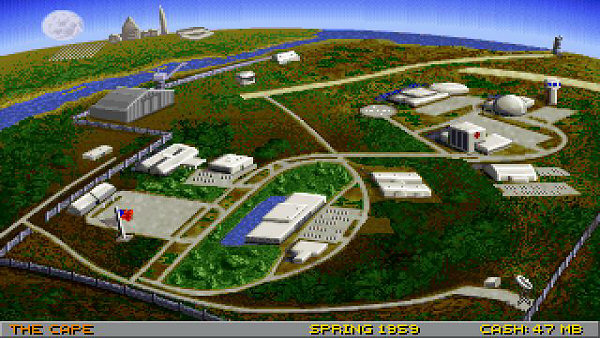
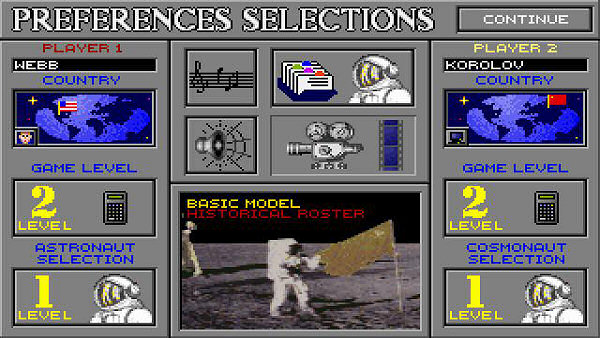
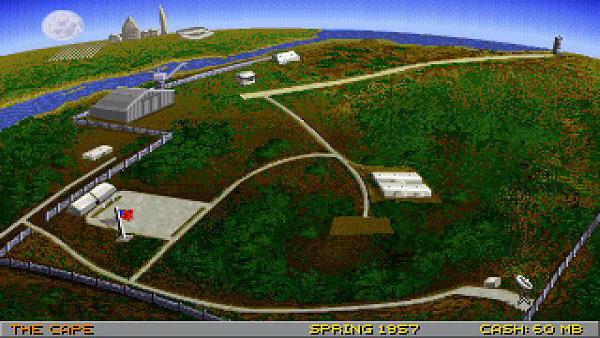
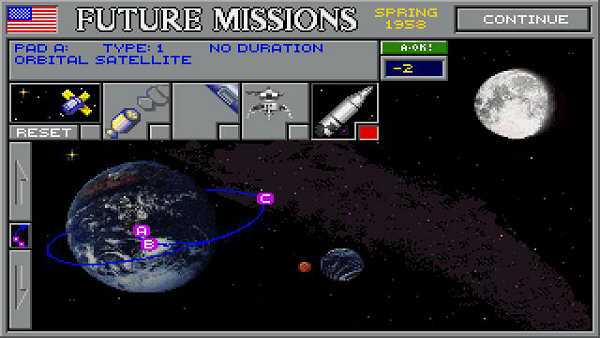
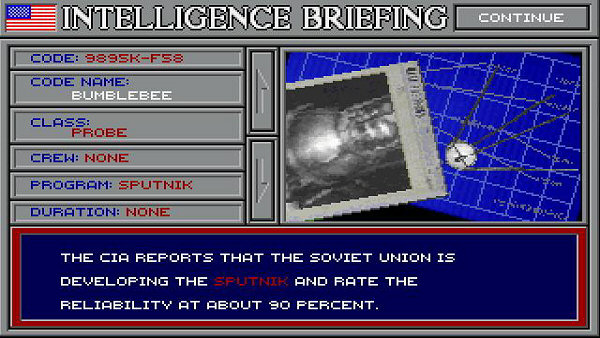
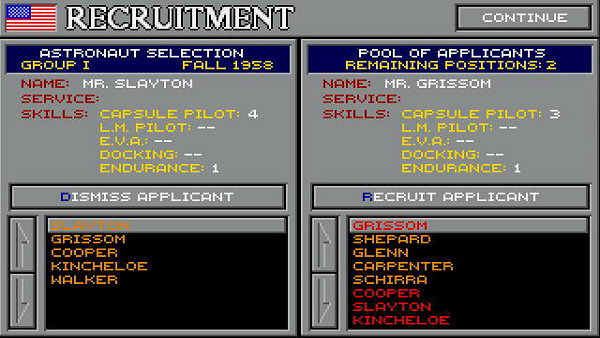
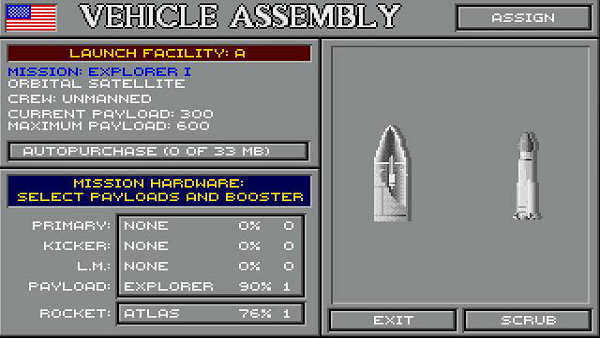
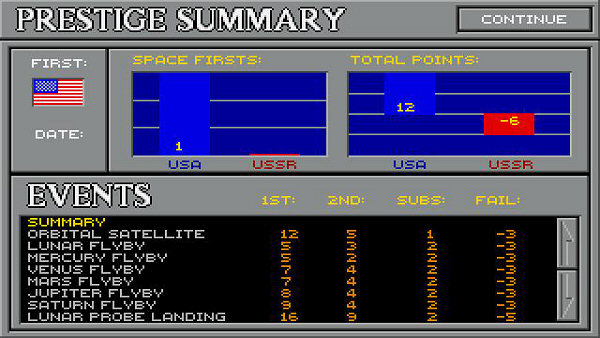
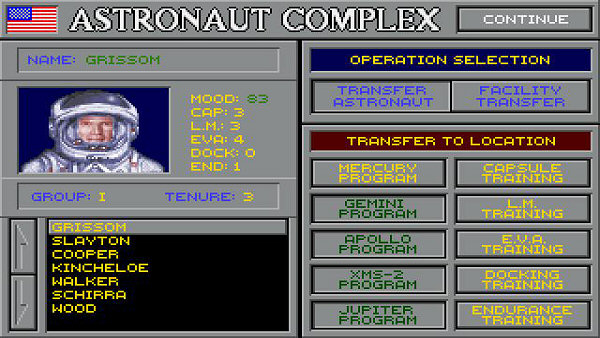
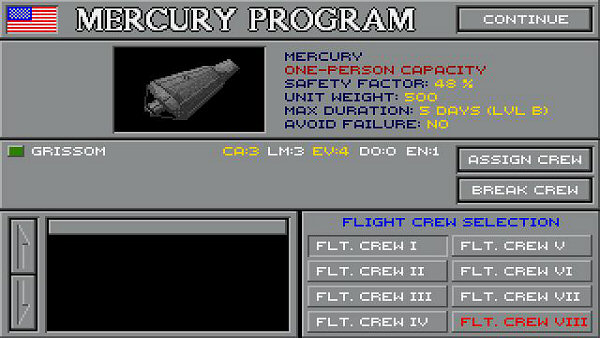

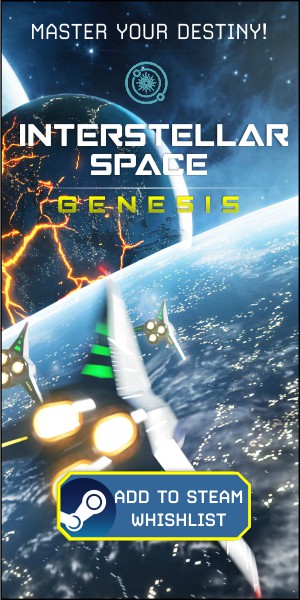





I am owning the original game and the only things i remember from the 90s were that the FMVs are indead a little bit repeating and sometimes the decision whether a mission fails or not felt too random. Nethertheless it was an entertaining game.
Has anybody played the board game?
Never played the original and I will take a look on this one.
But I’m also interested in this, is the board game any good?
I’ve played the board game. (And I have some fairly lengthy issues with BARIS as a result, but I wrote a fairly lengthy reply before saying “Meh” and then deleting it. I will note though as a PSA that in the Interplay version the random number generator is not, in fact, random. )
Liftoff, the board game version, is a game that frankly I like a lot, but it has some flaws. The differences between Liftoff and BARIS are pretty slight. Liftoff can accommodate up to 4 players. (Personally, I’ve played it with 6.) The duration and crew compatibility requirements in BARIS are thankfully not in Liftoff. Otherwise, they have basically identical turn structures. If you’ve played one game, you can pick up the other in a few minutes. And familiarity with Liftoff will let you understand a lot of what is happening backstage in BARIS. (All the misfortunes that happen in BARIS when you fail a safety check are present on the failure charts in Liftoff.)
However, let me note one more thing. There is a lot of randomness in both games, but it’s a lot more noticeable in Liftoff. For example, in BARIS when you do an Earth Orbital mission, you get a short sequence where the rocket launches, goes into orbit, get a screenshot of the astronauts, descend and get recovered. Takes about 30 seconds, IIRC. In Liftoff, it’s the same sequence, but you’ll be rolling percentile dice for each stage. Now, the exact same thing happens in BARIS (you can see the dice rolls in the panels on the bottom of the mission screen) but in Liftoff, the randomness is as subtle as a marching band. So if you’re not a fan of games where your plans can be wrecked by bad luck, this isn’t the game for you.
Also note, Liftoff is 24 years old at this point. Component-wise, it’s not going to be as polished as current games. But I still play it a couple times a year.
Loved the review of this off-beat vintage game! I’m trying it out and yes, it’s hard, needs a tutorial mode ;) May I suggest a review of Crisis in the Kremlin (1991)? It’s another unusual strategy game, being a “USSR simulator”, no less.
Ohhh looks interesting, thanks for pointing out.
Games in the 90’s sometimes lacked tutorials. UFO didn’t have one. It can be a benefit in some games, like Don’t Starve, but in a space management simulator, yeah, you need one.
But you are indeed right, I loved the review. Thank you very much Mister Chris Salt!
I’m happy that you’ve enjoyed the review and yeah, most games from the nineties didn’t have tutorials, but that’s what I suppose the manual is for :D Thankfully, the differences between the open source version of the game and the original version are pretty much nil, so the old version of the manual is still good. You can find the manual on Abandonia or on from The Docking Module.
Also, I’ll probably take a look at Crisis in the Kremlin and maybe have a crack at Shadow President while I’m at it :p They don’t quite make strategy games like they used to, they are much easier nowadays.
Huh? Is the clock wrong? Why is your post before mine?
Chris commented before you, but the comment only got in after you made your comment. The system recognized Chris’ comment as his first, due to the credentials he supplied (he used Chris instead of caekdaemon, as until now). So, his comment went to the moderation queue.
I have a time machine. But seriously, yeah, I changed from Caek to Chris so that people could find my comments easier.
But at least they had complete manuals explaining everything, something modern games lack for saving money.
Hm, i think i remember crisis in the kremlin from an old games magazine. Was that time when you know more games you want to play than you have money for. Pupil/Student problem ;)
When we got to Crisis in the Kremlin. Has anybody played Shadow President or Cyberjudas? I think these games may be similar.
Thanks for the review, Chris! I’m glad you found us, and the Docking Module. (I know the latter is kind of out of date, but as Race Into Space ramped up, I moved my efforts over there.) FYI, I see from the screenshots you’re using version 1.0; there’s any updated version, 1.1, available now, which offers a few improvements.
For those of you who asked about Crisis in the Kremlin, I’m a fan of that one too. It’s a surprisingly in-depth political sim given when it was made. I have a fan site out for it as well, which offers (among other things) a couple of mods to improve the game: http://peyre.x10.mx/Kremlin/index.htm.
Leon
raceintospace@yahoo.com
I actually used the open source version of the game, since it is identical and was no hassle at all :D
Sorry, I didn’t notice I was being confusing till just now! Yes, I meant the open-source version–that is, Race Into Space 1.0 and 1.1, not to be confused with Buzz Aldrin’s Race Into Space 1.00 (floppy version) and 1.1 (CD version). Big difference, but it never occurred to me till now that we’ve been using almost the same version numbers as the old DOS game.
Also, for those who’ve regretted that the game has no tutorial mode (which *is* an issue), the Docking Module does at least have a BARIS Tutorial in Word doc format which should be of some help in getting started.
Great review and great game, I really wonder if I these vintage games could be played on our smartphones or tablets, they have the computing power so it would be quite fun.
SQW, that could be done. The trouble is that you need people with the knowhow to port the game to another platform (iOS, Kindle, etc.) who are also willing to put time into the project. RIS has always been a small project–it had maybe five programmers in its heyday, all of them Windows, Mac, or Linux guys. And currently there are no programmers active at all. But if someone came on board (we do occasionally have someone show up who wants to get involved and then makes substantial contributions) who knew how and wanted to work on that, I’d be all for it. If you know of anyone, please write me, or ask them to–or (have them) post on the Sourceforge page.